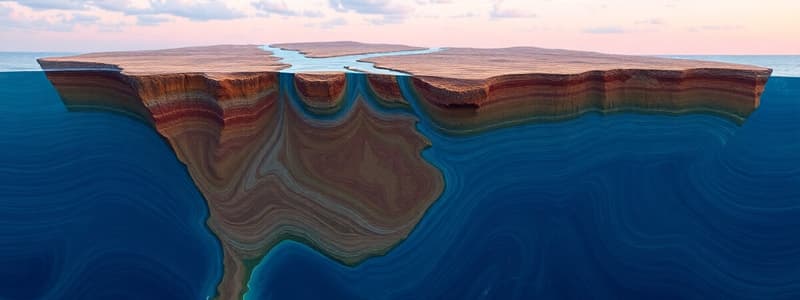Podcast
Questions and Answers
What is the primary driving force behind the movement of tectonic plates, according to the convection current theory?
What is the primary driving force behind the movement of tectonic plates, according to the convection current theory?
- The Earth's rotation causing a Coriolis effect on the mantle.
- Heat from the Earth's core causing convection currents in the mantle. (correct)
- The expansion and contraction of the Earth's crust due to seasonal temperature changes.
- Gravitational pull from the moon and sun.
Which of the following statements accurately describes what happens to the mantle rock as part of the convection process?
Which of the following statements accurately describes what happens to the mantle rock as part of the convection process?
- As the hot rock approaches the crust, it becomes more viscous and speeds up the plate movement.
- The rock is constantly melting and solidifying, creating a cycle that pushes the plates.
- The rock heats up, rises, cools, becomes denser, and then sinks back towards the core. (correct)
- The rock heats up near the crust and cools down near the core, reversing the normal convection process.
Based on the diagram and the text, where are trenches most likely located?
Based on the diagram and the text, where are trenches most likely located?
- At the boundaries where tectonic plates converge. (correct)
- At locations where tectonic plates are diverging.
- In areas with a very thin lithosphere and a lack of seismic activity.
- Within the Earth's core, marking the boundary between the inner and outer core.
If the convection currents in the mantle were to suddenly stop, what would be the most likely immediate consequence for the Earth's surface?
If the convection currents in the mantle were to suddenly stop, what would be the most likely immediate consequence for the Earth's surface?
Considering the Earth's structure as described, which layer is best characterized as semi-molten and directly involved in the convection process?
Considering the Earth's structure as described, which layer is best characterized as semi-molten and directly involved in the convection process?
Flashcards
What is Convection?
What is Convection?
The transfer of heat through a fluid (liquid or gas) by the movement of heated particles.
What are Convection Currents?
What are Convection Currents?
Heat from the Earth's core causing semi-molten rock in the mantle to rise.
What is the Lithosphere?
What is the Lithosphere?
The solid, outermost layer of the Earth, including the crust and uppermost part of the mantle.
What is the Asthenosphere?
What is the Asthenosphere?
Signup and view all the flashcards
What are Trenches?
What are Trenches?
Signup and view all the flashcards
Study Notes
- Tectonic plate movement, concerning convection and plate boundaries.
Earth's Structure and Movement
- The depth of the Mantle is 700KM
Convection Currents Theory
- Convection equals heat.
- Heat from Earth's core causes semi-molten rock in the mantle to rise.
- Hot rock rises and spreads out as it reaches the cooler crust.
- Magnetism and the Coriolis effect contribute to this process.
- The rock cools, becomes denser, and descends back to the core to be reheated.
- This process repeats in convection cells.
- The Earth's crust is cracked into plates
Plate Interactions
- Plates move due to convection cells.
- Plates can move in the same direction
- Plates can crash into each other or move apart.
Studying That Suits You
Use AI to generate personalized quizzes and flashcards to suit your learning preferences.




